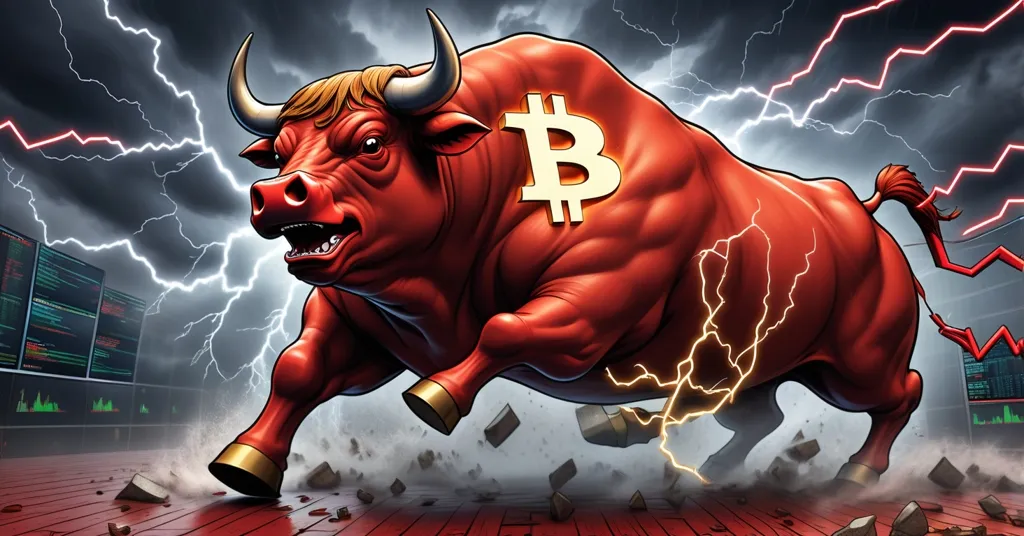Bitcoin Liquidation Shock: $102M Wiped Out in Hours as Bulls Dominate, Volatility Strikes Back

Bitcoin Liquidation Shock: $102M Wiped Out in Hours as Bulls Dominate, But Volatility Bites Back
Bitcoin just pulled off a financial sucker punch, obliterating $102.35 million in trading positions in a mere few hours. With a staggering 1,533% liquidation imbalance in favor of bulls, this event screams market confidence in BTC’s upward climb—yet a sudden price dip and shifting sentiment hint at turbulence ahead for traders.
- Huge Wipeout: $102.35M in Bitcoin positions liquidated, $95.96M from shorts.
- Bullish Crush: 1,533% imbalance shows bulls steamrolling bearish bets.
- Reversal Warning: Long positions hit late, price slips, and volatility looms.
Bullish Rampage: What Sparked the Chaos?
The crypto market is a battlefield, and Bitcoin just dropped a nuke on short sellers—traders betting its price would fall. Data from Coinglass, a platform tracking cryptocurrency market metrics, reveals that of the $102.35 million liquidated in a tight window, a whopping $95.96 million came from these shorts. Long positions—those betting on a price rise—accounted for just $6.38 million initially, creating a jaw-dropping 1,533% imbalance favoring the bulls. For the uninitiated, liquidation is when an exchange forcibly closes a trader’s leveraged position because they can’t cover their losses. Think of it as borrowing big to bet on a horse race—win huge or lose everything if your pick stumbles. Leveraged trading amplifies gains but turns into a slaughterhouse when the market moves against you, as these short sellers learned the hard way.
This carnage unfolded as Bitcoin’s price teased a peak near $108,000, fueled likely by institutional muscle. Spot Bitcoin ETFs, investment vehicles allowing traditional investors to gain exposure to BTC without owning it directly, saw $542 million in inflows on a single day recently, part of a 12-day buying spree according to The Defiant. That’s serious money from big players, often a catalyst for bullish surges that crush anyone daring to bet against the king of crypto. This event wasn’t just numbers on a screen—it was a brutal display of market belief in Bitcoin’s ascent, at least for a fleeting moment.
Sudden Reversal: Longs Take a Hit
But don’t pop the champagne yet. Just as the bulls seemed unstoppable, the market flipped. In the final hour of this liquidation frenzy, $547.42k out of $552.13k in wiped-out positions came from longs, with shorts contributing a measly $4.71k. Bitcoin’s price, after flirting with $108,000, slid 0.58% to hover around $107,000, reflecting recent market sentiment. Why does a dip hurt longs? Simple—when the price falls, their borrowed bets lose value, and if they can’t cover the difference, the exchange boots them out with a loss. This shift isn’t a minor hiccup; it’s a red flag. Are whales—big holders with deep pockets—cashing out profits? Is retail panic setting in? Or are trading algorithms overreacting to a tiny pullback? Whatever the trigger, investor nerves are fraying, and the weekend looks set for more bumps.
Market Context: Pain Beyond Bitcoin
Zooming out, Bitcoin isn’t bleeding alone. The total crypto market cap dropped 2% to $3.4 trillion, with leveraged liquidations across all cryptocurrencies hitting $206 million in 24 hours, per The Defiant. Ethereum, the second-biggest player with its smart contract ecosystem, saw $70 million in liquidations despite a 1.3% price uptick to $2,445. XRP, tied to Ripple’s payment solutions, took a 3% hit to $2.12, while Solana held steady at $143. Bitcoin’s own 24-hour liquidation tally came in at $43 million—lower than the few-hour spike reported by Coinglass, raising questions about timing or data scope. For newer folks, this ripple effect across markets matters: Bitcoin often sets the tone, but altcoins can either amplify the chaos or offer a buffer with their unique niches, like Ethereum’s decentralized finance (DeFi) apps that Bitcoin isn’t built to handle. The pain is shared, but the dynamics differ.
Macro Pressures: Fed and Geopolitics Add Fuel
External forces are stirring the pot. U.S. jobless claims last week came in at 236,000—lower than expected—hinting at a robust labor market. Good news, right? Not quite. It also fuels fears of delayed Federal Reserve interest rate cuts, a move that often spooks risk assets like Bitcoin. Fed Chair Jerome Powell’s recent “wait-and-see” stance on policy, paired with his note that inflation still exceeds the 2% target, only thickens the fog. Call it a “wait-and-suffer” game for crypto traders craving cheaper money. Then there’s the Middle East mess—U.S. strikes on Iranian nuclear sites and Iran’s Supreme Leader talking tough. Global risk aversion spikes in times like these, and Bitcoin plays a weird dual role: part safe haven, part speculative gamble. Traders are left guessing which hat BTC will wear next, often wondering about the root causes of such price volatility.
Long-Term Outlook: Optimism Amid the Wreckage
Despite the short-term madness, there’s reason for hope among Bitcoin faithful. Paul Howard, Senior Director at crypto hedge fund Wincent, keeps a steady hand with a “bullish outlook mid-long term on [crypto] assets,” even as geopolitical risks loom. Those ETF inflows aren’t chump change either—they signal Bitcoin maturing into a recognized asset class, a middle finger to the old financial guard. As advocates of decentralization and personal freedom, we see this as progress toward disrupting the status quo. But let’s not ignore the ugly truth: leveraged trading is a meat grinder. Events like this, where millions vanish in hours, expose the brutal downside of chasing quick gains, as explained in detailed resources about crypto liquidations. We’re not here to peddle 10x fantasies or hopium—respect the market’s ruthlessness or get chewed up.
One nagging issue: the numbers don’t fully align. Coinglass pegs Bitcoin’s liquidation at $102.35 million in a narrow window, while broader 24-hour reports cite $43 million. Is this a timing quirk, exchange-specific spikes, or shaky data aggregation? Transparency is non-negotiable in crypto—scammers thrive on confusion, and we’re not playing their game. Standardized reporting is a must if we’re serious about building trust in this space.
Playing Devil’s Advocate: Is This Bull Run Sustainable?
Let’s poke the bear. Sure, the 1,533% liquidation imbalance showcases Bitcoin’s raw power, but are these ETF inflows a golden ticket or a Trojan horse? Tying BTC to Wall Street’s machinery risks turning it into a puppet of the very system we aim to dismantle. Institutional adoption boosts legitimacy and liquidity, but at what cost to decentralization? And after past bull runs—like the 2021 surge followed by painful corrections—shouldn’t we question if this momentum is just another setup for a fall? Bitcoin maximalists might scoff, claiming BTC is the only game worth playing, and these numbers back them up, as seen in community reactions on Reddit discussions. Yet altcoins like Ethereum, powering stablecoins and DeFi protocols, fill gaps Bitcoin doesn’t touch. Both have a seat at the table in this financial uprising.
Historical Echoes: Just Another Day for Bitcoin?
This isn’t Bitcoin’s first rodeo. Back in March 2020, during the COVID panic, BTC crashed over 50% in days, triggering massive liquidations as leveraged bets imploded. The 2021 bull run saw similar spikes—shorts obliterated on the way up, longs crushed on the pullbacks. Is this $102 million wipeout exceptional, or just Tuesday in Bitcoin land? History suggests volatility is baked into BTC’s DNA. It’s a feature, not a bug, for a tech hell-bent on shaking up the world. But it’s also a reminder: over-leveraging is a fool’s errand. If you’re new to this, start small, set stop-losses to cap your downside, and don’t bet the farm on a single swing.
Trader Psychology: Why the Missteps?
Why did shorts pile in despite Bitcoin’s momentum? Likely, they banked on a post-surge correction—a common pattern after rapid climbs. And why did longs get blindsided by the dip? Probably overconfidence or fear of missing out (FOMO), riding the wave without a safety net. Social media buzz, though speculative, paints a picture of short sellers raging while longs sweat over margin calls. Sentiment can turn on a dime in crypto, often faster than fundamentals justify. It’s less about logic, more about herd behavior—something even algorithms can’t always predict, as explored in trader impact analyses. This event is a case study in why emotional discipline and risk management trump gut feelings every time.
Key Takeaways and Questions for Bitcoin Enthusiasts
- What drove the $102.35 million Bitcoin liquidation event?
A sharp price surge toward $108,000 demolished short positions, wiping out $95.96 million as bullish momentum overwhelmed bearish bets. - Why does a 1,533% liquidation imbalance scream bullish?
It shows extreme market faith in Bitcoin’s rise, with shorts liquidated over 15 times more than longs at the event’s peak. - What caused the flip to long position liquidations?
A 0.58% price drop to $107,000 and wavering sentiment likely spurred profit-taking or panic, shifting pressure to longs in the final hour. - How do Fed policy and geopolitics impact Bitcoin here?
Uncertainty over delayed rate cuts and Middle East tensions heighten risk aversion, adding volatility to Bitcoin’s price and rattling traders. - Should traders expect more chaos after this spike?
Without a doubt—rapid mood swings, broader market declines, and weekend uncertainty point to potential further turbulence, so stay cautious.
Bitcoin’s latest liquidation saga is a blazing reminder of its untamed nature—a force for decentralized power that laughs in the face of legacy finance, yet a ruthless beast that spares no one caught off-guard. Whether you’re a battle-hardened OG or a wide-eyed newbie, the message rings loud: embrace the volatility, ditch the hype, and keep your wits sharp. Are you braced for Bitcoin’s next wild swing, or is playing it safe your new mantra?



